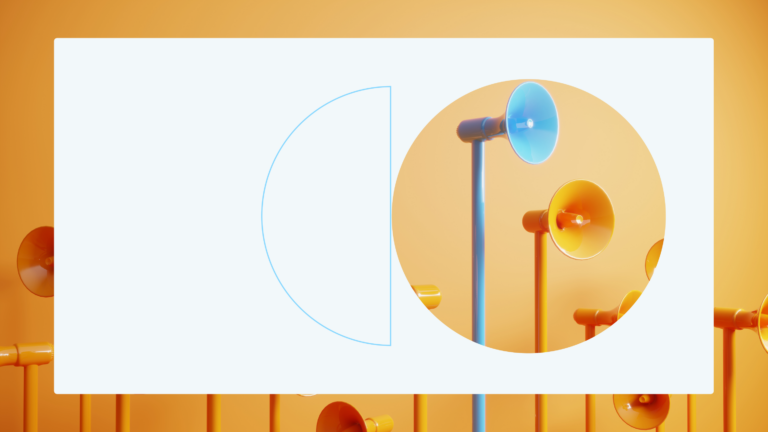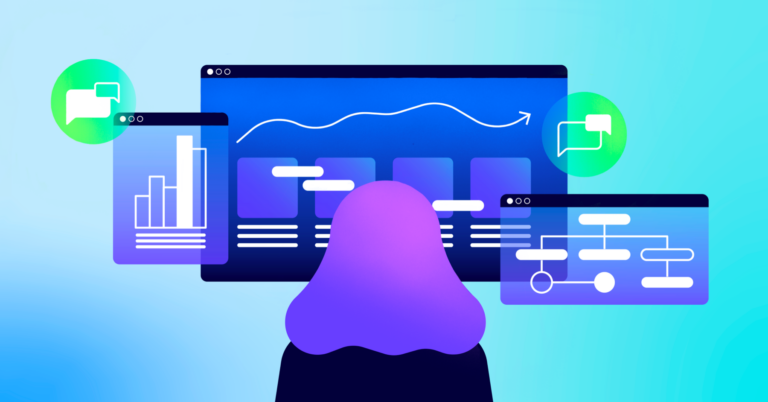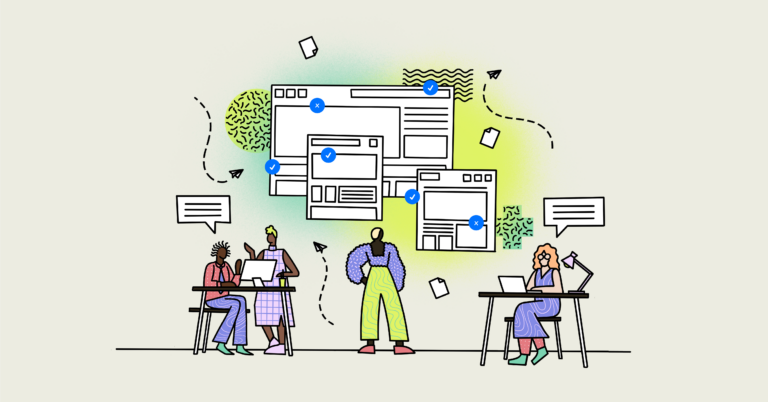Understanding your organization’s user research maturity
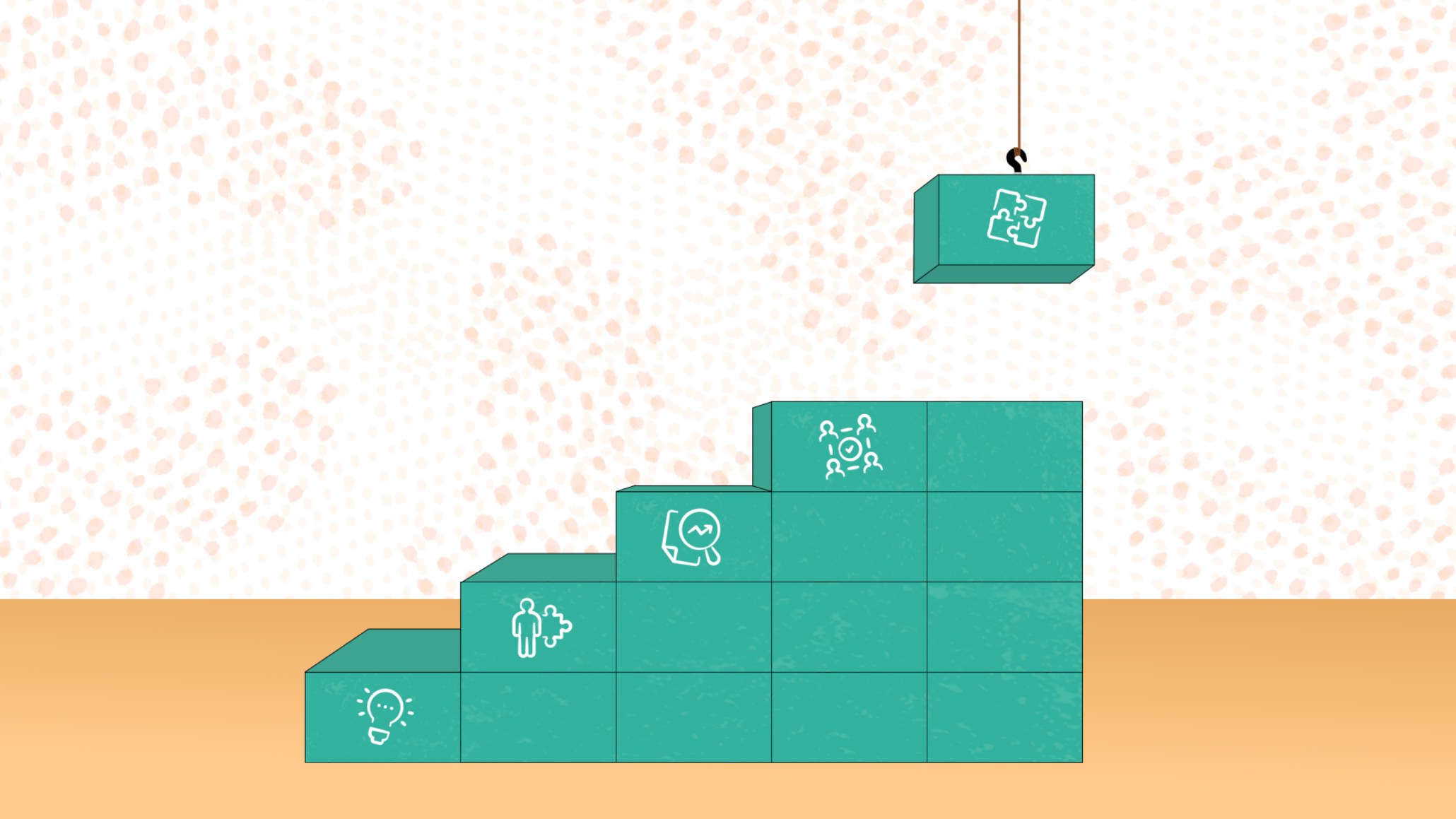
Today, user centricity is the key to developing digital tools and services that succeed. While it’s vital to pursue user research in the course of your product design and development work, it’s just as important to understand how to pursue user research based on your research maturity—and how ready your organization is to invest in and pursue the appropriate activities. When you understand where you are on the research maturity scale, you can build an approach with the right momentum and impact at each stage—and ultimately make a plan to edge out your competition through evidence-based design.
We’ve helped countless organizations of many sizes and stages build or strengthen a research practice. Below we’ll introduce you to the research maturity model and share the essentials of each stage with recommendations about how to move onto the next.
Research maturity model
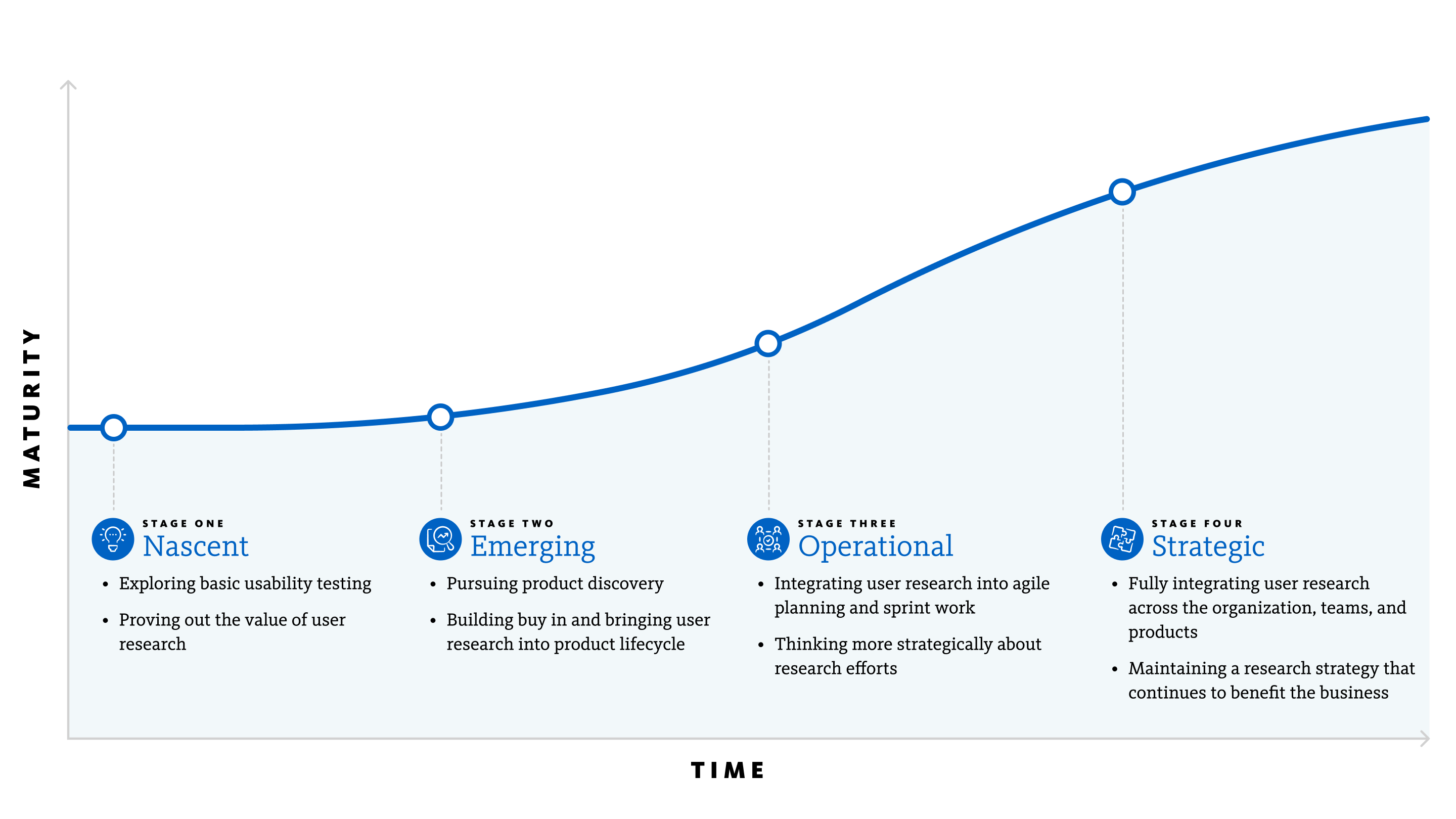
As with any practice in your organization, your user research practice will usually fall into one of a few stages in a maturity model. Depending on where you fall in the chart above, you’ll need to pursue different activities and focus on specific goals in each stage.
It’s important to note that progress in these stages is usually cumulative, and that it’s often not possible to jump immediately into a more advanced stage without laying the necessary groundwork in earlier stages.
It’s also important to note that we consider “user research” to mean any activity that involves talking to users. While activities like heuristic evaluations, cognitive walkthroughs, and other UX gut checks offer some valuable feedback in a pinch, they are often missing perspective from the key element of user research: the user. If your ultimate goal is to mature by learning more about the effectiveness of your service or product, you’re not going to help your organization get to stage 4 without prioritizing a two-way conversation with users.
User research stages by organizational maturity
In order to help your organization advance through these stages, you’ll need to identify which stage sounds most similar to your user research practice, focus on the key activities and challenges in each stage, and work towards goals that will help you mature.
Stage 1: Nascent
When your user research efforts are at a nascent stage, your team is exploring basic moderated usability testing. Your goal is to start proving out the value of user research to the leaders at your organization.
At this stage:
- You either have no user research data or very little—and you’re looking for ways to evangelize the value of spending extra time and money on user research.
- The research you do have available may include a small sample size or not answer all of your team’s questions—which still provides value, but leaders in your organizations are skeptical about it.
- Your team has some behavioral data (clicks, metrics on who is adding items to a shopping cart, etc.) and you’re trying to make design decisions with that in mind. But you’re also aware that this data is limited, and that focusing on it could end up leading you down the wrong path.
- There are one or two key user activities that you want to know more about or see your audience using, so you’re focusing your initial user efforts there. You’re hoping to get more information, start making evidence-based decisions, and begin proving out the value of research.
Ways to enhance your efforts in stage 1:
Begin differentiating user research from other types of market research and user data. As mentioned above, a lot of organizations in this stage tend to take information from on-site metrics and analytics, market research initiatives, and more, and use it as an alternative to user research. First, the findings from market and user research are not always 1:1. And often, the behavioral data you’ll see on your tools and technology won’t tell you anything about user intent. The most valuable user research data at this stage should tell you what people are doing—and what their intentions are.
Survey your customer service team. If you’re still trying to make a case for budget, you could start by asking the internal people working directly with your customers about the type of regular feedback they’re hearing. This likely won’t cost extra money, and it will help you start gathering some information about your audience’s common questions and pain points—as well as the tools and features they value. You can also layer the data from this activity into your usability testing to develop a more rich picture of your audience needs.
As you gather more information, show it to leaders. This phase is the perfect time for socializing research within your team and across departments. If there’s still some skepticism about the value of user research, you should show leaders something concrete that provides insight your organization wouldn’t have otherwise.
In phase 1, your user research efforts will start uncovering active design and development issues and answer the question: did we build the thing right? You will also be able to gradually socialize the concept, secure a bigger user research budget, and share the value of the practice to the business.
Stage 2: Emerging
When your user research efforts are at an emerging stage, you’re usually doing more product discovery. Your goals are focused on building up buy-in and integrating user research findings into the product lifecycle.
At this stage:
- Your product design team is putting more focus onto digital challenges that users are actually experiencing—with feedback gleaned from user research groundwork laid in stage 1.
- You’re considering more long-form research interviews like diary studies. If you’ve started, you’re seeing that these interviews are helping your team discover deeper problems with your products and services—and even problems that your users might not realize are problems.
- Your team is beginning to think more divergently about what you’re building. For example, when you’re given a directive by the business to build something, you’re able to ask why and understand how your efforts are contributing to the broader picture.
- Your research efforts might still be isolated to one product, team, or function, but you’re seeing signs of stronger research collaboration and insight sharing across departments and products.
Ways to enhance your efforts in stage 2:
Regularly ask yourself and your team key questions about user behavior. Some questions might sound like, “what is the ideal user behavior we’re looking for?” or, “is this the right problem to solve?” You have an opportunity at this stage to begin driving better business results through the research insights you gather.
Gain familiarity with new methodologies, like diary studies and contextual inquiries. More long-form data will be useful at this stage since you already have a foundation of regular user interviews. At this point, the people around you should be properly invested in the value of research, so you can gather stronger insights. But, be sure to continue socializing the value of these longer form efforts. Nothing hurts research credibility more than a long and expensive study that senior leadership ignores.
Here, you’re gathering stronger buy-in, your activities are integrated into the broader product work, and you’re more able to show that research can help answer the question: did we build the right thing? If your product or service is providing concrete value to your audience, you’ll have more influence to further shape it in future stages.
Stage 3: Operational
When your user research efforts are at an operational stage, research leaders should have more say in how products are being built—and research is not only integrated into agile planning, it directly impacts sprint work. Your goal is to start thinking more strategically about your research work and the broader business impact.
At this stage:
- Your team has proven the value of research enough to ask for investment (time, budget, people, etc.) to gather in-depth data. You’re pursuing more longitudinal research activities—spending time with a key person in your customer experience journey, observing someone’s full day, or answering more focused questions about specific tasks. All of this is helping you determine larger patterns in your customer experience.
- You’re getting more exposure to product leaders at your organization. And these leaders are actually sitting in on some of the in-depth sessions to see them in action. These moments are helping you—because while you can give a strong research readout to a leader, having them see the actual feedback and better understand the voice of customer is much more influential.
Ways to enhance your efforts in stage 3:
This is a good moment to strive for building a ResearchOps practice. Whether you’re establishing it or refining a practice that’s starting to emerge, ResearchOps will help you put a much-needed structure behind research efforts that are growing and becoming more complex—which is a necessary foundation for the next, more strategic phase in your maturity. A ResearchOps practice will also help you solidify user research as a purposeful, effective, and indispensable force in your design and development work, and it will clearly establish the processes and resources you need to continue to grow it.
At this stage, you’re getting more involved in planning sessions in your part of the organization, your team has leverage, and you’re more able to influence the product design and development work that’s coming down the road. You’re beginning to think more strategically about the research you’re doing.
Stage 4: Strategic
When your user research efforts are at a strategic stage, user research is fully integrated across the organization, teams, and product suite. Your goal is to maintain a system that allows user research to stay relevant and valuable to the business without regressing to earlier stages.
At this stage:
- Your team is doing user research for the whole business experience rather than on a product level. Perhaps your team and the relevant business leaders are gathering insights into things like the 2-month process of customers in the shopping process.
- You have a better understanding of the full scope of the business and how the entire customer lifecycle is contributing to business success.
- You also understand the user experience internally—from the perspective of employees keeping customer activities running, third party vendors, and across departments.
- Research is built into the culture of the business.
Ways to enhance your research efforts at this stage:
Ensure executives are consistently sitting in on user research. You don’t have to involve the same executives or have them sit in on the same type of interviews, but you should make executive participation a built-in part of your research planning. Some common advice suggests that in the best scenarios, executives at your company are sitting in on two hours of research interviews every six weeks, if possible.
Think of the strategic stage as an active practice you need to maintain. Remember that you don’t just arrive at this level of research maturity and stay here. This stage is like a workout, and you must stay sharp on the fundamentals that got you here: consistent socialization about the value you bring, strong collaboration across departments, proficiency with a variety of research activities, and a growing ResearchOps practice. Failure to exercise these muscles can allow an organization to regress into one of the previous stages—and allow a competitor to move ahead.
Here, you should see solid organizational buy-in and influence across departments, products, teams—and your team should be focused on continuing to make a broad impact.
Mature your user research efforts
Navigating the stages of user research maturity is a progressive journey that requires thoughtful planning and strategy at each step. With a focus on the unique challenges and opportunities that each stage presents, you’ll be able to champion your organization’s user research practice more effectively—and with stronger influence and impact to the business over time.
Are you looking to better understand where your organization lands on the research maturity model? Our experts can help your team build or improve your research practices. Let’s talk.

